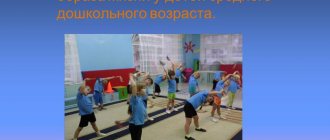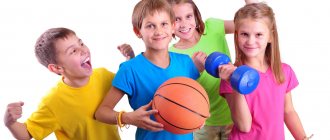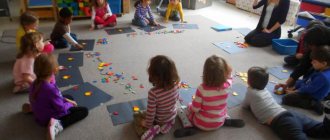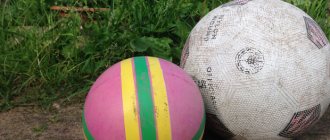Long-term work plan on healthy lifestyle for the senior group for the 2017/2018 academic year
Municipal budgetary preschool educational institution
Combined kindergarten No. 46 “Owlet”
Long-term work plan for healthy lifestyle
4 senior groups for the 2018/2019 academic year
Teachers: Trofimova S. M.
“Health is a treasure (and at the same time the only one) for the sake of which it is really worth not only sparing no time, effort, work and all sorts of benefits, but also sacrificing a part of life itself for it, since life without it becomes unbearable and humiliating.”
M. Montel.
TASKS:
To promote favorable adaptation in kindergarten, the establishment of good relationships between teachers and children in the group, stable emotional and positive well-being and activity of each child. Continue to strengthen and preserve the health of children. Develop cultural, hygienic and self-care skills. Develop basic movements. Prevent fatigue. Along with visual-effective thinking, form elements of visual-figurative thinking. Develop children's perception, attention, memory. Enrich children with a variety of sensory experiences.
Physical education and health work (Educational field “Physical culture”)
During the year, under the guidance of medical personnel, taking into account the health of children and local conditions, carry out a set of hardening procedures using natural factors: air, sun, water. Teach children to wear lightweight clothing indoors. Ensure the duration of their stay in the air in accordance with the daily routine. Cultivate interest and desire to participate in outdoor games and physical exercises while walking. When carrying out hardening activities, carry out a differentiated approach to children, taking into account their health status.
Mode of physical activity of preschool children
| Type of activity and form of physical activity | Duration, min | Features of the organization |
| 1. Training sessions | ||
| Physical Culture | 25 | 3 times a week. During the warm season, 1 lesson is held outside. |
| 2. Physical education and health activities | ||
| Morning exercises | 7-10 | Every day in groups, in the warm season outside. |
| Motor warm-up during a break between classes | 2-3 | Daily. In the 1st and 2nd junior groups, a general warm-up is carried out in the morning and evening |
| Physical education minute | 3-5 | Every day, as necessary, depending on the type and content of classes, the state of health of the children |
| Outdoor games and exercise during walks | 25-30 | Every day, during walks, organized by the teacher |
| Outdoor games and physical exercises in a group | 15-20 | Every morning and evening 1-2 outdoor games |
| Exercises on beds after a nap, breathing exercises, self-massage, hardening activities | 8-10 | Breathing exercises – from the middle group, massage and self-massage – from the 1st junior group |
| 3. Active recreation | ||
| Independent motor activity | – | Every day (in a group and on a walk), under the guidance of a teacher. The duration depends on the individual characteristics of the children and their state of health. |
| Finger gymnastics | 1-3 | Every day during classes. |
Health work
| Gymnastics (in the morning, after sleep) | Daily, 10-12 minutes |
| Light and air baths: | -ventilation (daily); -walks in the open air; in autumn and winter 1-2 times for 1.5-2 hours; in summer from 2. h; - sleeping with open transoms, sleeping without T-shirts (in summer) |
| Hygiene and water procedures: | - washing; - hand washing (daily) |
| Hardening | — walking barefoot (at a floor temperature of 18° C) — play massage; |
| Quartzization of groups | daily |
System of physical education and health activities
1. Morning exercises
-game exercises to develop attention and accuracy in performing actions; -exercises using a variety of modules; -exercises with simple simulators; -morning exercises in combination with speech and breathing exercises; -work on posture control
2 Physical education
-motor activity of training type; -activities of a gaming and plot-game nature; -Rhythmic gymnastics; -diagnostics of testing skills; -correctional activities for the development of children's creativity.
3 Motor warm-up during the break between NODs. Physical education minute
-Game exercises of low and medium intensity; -rhythmic movements; -exercises for the development of fine motor skills; - game exercises of a correctional orientation.
4. Gymnastics after a nap in combination with contrast air baths.
- warm-up in bed; - gymnastics of a plot-game nature; - a set of exercises on simulators in combination with health-improving walking along massage and ribbed paths; - a set of exercises for the development of fine motor skills and visual-spatial coordination; -exercises to strengthen the main respiratory muscles.
5 Outdoor games and physical exercises during a walk in subgroups and individually.
-games of low and medium intensity, -game exercises for the development of attention, spatial concepts and orientation; -exercises to normalize muscle tone and develop strength qualities; -sport exercises; -games with elements of sports; -folk games;
6. Health Day
- plot and thematic; - outdoor games and exercises at the request of children; -sports games and exercises.
7. Physical education holidays and leisure activities
8. Hardening
-contrast air baths; -walking barefoot, lightweight clothing; -washing with cool water.
Forms of work to create a healthy lifestyle.
| Month | Subject | Goals | Conversations | Pract. tasks | Games | ||
| Role-playing | Didactic | Movable | |||||
| September | Child and society | — To form an idea of a person as an integral rational being; the ability to recognize oneself in society; skills of interaction with children and adults; ideas about gender. — Teach cooperation skills with children and adults; rules of behavior in society. — Cultivate respect for yourself, for children and adults. | “Me and other people”, “My family”, “Good deeds”, “My friends”. Goals: to form in children ideas about the similarities and differences of people by age, gender, height, hair color, eyes, etc. Expand and consolidate ideas about relatives. | Drawing: “My portrait”, “My family”, “Good mood”, “Interesting stories”. | “Family”, “Mothers and Daughters”, “Kindergarten” | “Family”, “My name”, “Whose name is it”, “Call it affectionately”, “Pick up a sign”, “Whose? Whose? Whose?”, “The fourth odd one,” “Collect the picture.” | “We walk around each other”, “Find yourself a partner”, “Loaf”, “Snake”, “Dance, dance, tell me what you can.” |
| October | The human body | — learn to distinguish and name the main parts of the human body (head, arms, legs, torso, etc.). - form ideas about their functional purpose. | "How the human body works." Goal: to teach to distinguish and name the main parts of the human body (head, arms, legs, torso, etc.). | “Color the parts of the body”, “Circle the moving parts of the body”, “Circle the feet and hands with a felt-tip pen.” | "Examination by the Doctor" | “The face in the mirror”, “My assistants”, “What color is the hair”, “Wonderful pictures”, “Who can show the body parts faster”, “Look and call”, “What the artist forgot to draw” | “Fun exercise”, “Small and big feet”, Fingers and hands”, “Fast and nimble feet”, “The sea is agitated.” |
| November | Studying your body | — To form an idea of the integrity of the human body. — Talk about the location and importance of the heart, stomach, kidneys, spine and lungs for human life and health | “How our body works”, “How we breathe”, “Eyes”, “What role does the heart play in human life”, “What is harmful to our lungs”. | Modeling: “Merry men.” | "Examination by the Doctor" | “What’s inside us”, “What I feel”, “Mirror”, “Listen and show”, “Breathe - don’t breathe”, “Who will show you faster” | “Fun exercise”, “Small and big feet”, Fingers and arms”, |
| December | Human mouth, ears, eyes, their functions and structure | — To form an idea of the role of the mouth and teeth in a person’s life, the need for regular and proper oral care. — Develop skills in proper brushing of teeth. | “Healthy teeth mean a healthy person.” "The role of the mouth in human life" Goal: to form an understanding of the role of the mouth and teeth in a person’s life, the need for regular and proper oral care. | “Say words without touching your tongue to the roof of your mouth, front teeth, etc.” | "Masha at the dentist." | “Happy and sad teeth”, “Where should a toothbrush sleep”, “What foods are good for our teeth”, “Collage”, “Cubes”, “What is good for teeth?”, “What is good for eyes?” | “Hide your teeth in the house.” |
| January | Health and illness | — Introduce the concepts of “health” and “illness.” — Learn to take care of your health, report your health to adults, avoid situations that are harmful to your health, and recognize the need for treatment. | “How to properly take care of your health”, “What causes various diseases” — Excursion to the medical office. | Watching the cartoon "Doctor Aibolit". Drawing: “I am healthy, I am cheerful”, “Scarf for a sick doll”. | “Visiting a patient”, “Pharmacy”, “Ambulance” | “If you have a cold”, “Treating a doll”, “Visiting a sick person”. “My teeth hurt,” “Health and mood,” “Who is healthy,” “Why is Masha feeling bad?” | |
| February | Personal hygiene and daily routine | — To develop the need for hygiene and neatness in everyday life. — Expand ideas about the importance of cleanliness and daily routine for human health. | Watching the cartoon “Charging”, “Moidodyr”. | Looking at the illustrations: “Daily routine”, “When this happens”, “Rules of behavior at the table”. | “Cooking lunch”, “Kindergarten”, “Day off”. | “My day”, “When it happens”, “The doll goes for a walk”, “Masha-zamarasha”, “Merry helpers”, “What is good and what is bad”. | “Fun morning exercises”, “Day and night”. |
| March | Healthy Eating School | — To form an idea of the dependence of human health on proper nutrition. — Update ideas about rational nutrition. — Learn to determine the quality of products based on sensory sensations. | “What foods are good for us”, “When I eat, I am deaf and dumb”, “Why do we need vitamins”. Foster the need to adhere to a diet, eat vegetables and fruits, and other healthy foods. | Modeling: vegetables and fruits. Drawing: answers to riddles. | “Healthy food store”, “Eat for health”, “Advertising”, “Cooks” | “Healthy treats”, “What grows in the garden”, “Find healthy products”, “Set the table for breakfast, lunch, dinner”, “Edible and inedible”, “nutritional rules” | "Planting and harvesting vegetables" |
| April | Sun, air and water are our best friends | — To form ideas about the role of sunlight, air and water in human life and their impact on health. — Talk about the relationship between human health and natural and weather phenomena. | “Drinking clean water means living long,” “Sun, air and water.” | Entertainment “We must, we must wash ourselves!” | “On the River”, “Visiting Doctor Znayka”. | “Pick a pair”, “Find the artist’s mistake.” | "Free Swimming", "Sunny" |
| May | Healthy lifestyle | — To form an idea of the components of a healthy lifestyle: physical activity, balanced nutrition, hardening, emotional balance, breathing, health care. - Cultivate a positive attitude towards him. | Watching the cartoon "Oh and Ah." | Game tasks: “What you need to do to live long”, “Why do you need morning (after nap) exercises”, “How to brush your teeth correctly”. | “Polyclinic (appointment with an ophthalmologist, ENT doctor, surgeon, etc.), “Physical education class,” “At the dinner table.” | “Tell Dunno”, “Fold the picture”, “One Hundred Steps to Health” | games - relay races, outdoor games according to the age of the children. |
Education of cultural and hygienic skills (Educational field “Health”)
- Cultivate the habit of keeping your body clean, your clothes and hair tidy.
- Cultivate the habit of brushing your teeth yourself, keeping your nails clean, turning away to the side when coughing and sneezing, and covering your mouth and nose with a handkerchief.
- Develop the skill of dressing and undressing quickly, neatly, keeping your closet in order, and tidying your bed.
- Continue to improve food culture: use cutlery correctly, eat carefully, quietly, with a napkin, maintaining correct posture at the table.
| Regime processes | Skill content | Methodical techniques |
| First quarter | ||
| Nutrition | Improve the ability to hold a fork with your thumb and middle finger, holding it on top with your index finger, eat different types of food without changing the position of the fork in your hand, but only slightly turning your hand | Conversation “Let’s remember how to eat properly.” Looking at illustrations. Reading: M. Vishnevetskaya “Dear Aunt Semolina Porridge” |
| Dressing - undressing | Strengthen the ability to dress and undress independently in a certain sequence, correctly place your things in the closet, carefully fold and hang clothes on a chair before going to bed, consolidate the ability to use different types of fasteners. Recognize your clothes and not confuse them with other children’s clothes | Conversation “Every thing has its place.” Reading: I. Bursov “Galoshes”, S. Mikhalkov “I myself.” Didactic exercises: “Who will put the clothes correctly”, “Button and unbutton”, “Remember your things”. |
| Washing | Improve washing skills: soap your hands until foam forms, rinse thoroughly, wash your face, wipe dry with a towel, use a handkerchief in a timely manner | Reading: I. Ishchuk “My palms.” Didactic exercise “Let’s tell the kids how to wash themselves” |
| Keeping clothes and shoes in order, making the bed | Improve the ability to make a bed: straighten a sheet, cover it with a blanket | Didactic exercise “How to make your bed correctly |
| Second quarter | ||
| Nutrition | Learn to eat the second course. Strengthen the ability to use a napkin as needed | Conversation “Culture of behavior while eating.” Reading: S. Makhotin “Breakfast” |
| Dressing and undressing | Strengthen the ability to independently maintain cleanliness and order in your closet | Conversation “Cleaning up the clothes closet” |
| Washing | Strengthen the ability to quickly and correctly wash your face and dry yourself with a towel, taking it from the cabinet and unfolding it on your palms | Reading: A. Barto “The Dirty Girl” |
| Keeping clothes and shoes in order, making the bed | Learn to dry and clean your clothes, wash, wipe, clean your shoes. Learn to sew on torn buttons. Take part in changing bed linen: lay down a clean sheet, put on a clean pillowcase | Conversation “How to take care of your clothes.” Reading: D. Krupskaya “Purity” |
| Third quarter | ||
| Nutrition | Strengthen the ability to use cutlery correctly, eat a second dish using a fork without moving them from hand to hand, eat with your mouth closed, chew food silently | Conversation “Food Culture”. Reading: D. Grachev “Lunch” |
| Dressing - undressing | Strengthen the ability to neatly fold clothes before going to bed, turn the sleeves of a shirt or dress inside out, straighten clothes, carefully place shoes | Reading: M. Zoshchenko “Stupid Story” |
| Washing | Improve the ability to wash quickly and accurately, and maintain order in the washroom. Reinforce the ability to wash hands after using the toilet and as needed | Reading: E. Vinokurov “Bathing Children” |
| Keeping clothes and shoes in order, making the bed | Form the habit of taking care of your appearance, reminding your comrades of shortcomings in their appearance, and showing a desire to help them. Take part in changing bed linen: lay down a clean sheet, put on a clean pillowcase | Reading: A. Zhigulin “I lost my hairpin in the grass.” Didactic exercise “How to help a friend” |
| Fourth quarter | ||
| Nutrition | Improve the ability to use cutlery correctly: while eating, hold the cutlery above the plate, and at the end of the meal, place it on the edge of the plate, not on the table | Reading: O. Grigoriev “Jam” |
| Dressing - undressing | Improve the ability to quickly dress and undress, carefully hang things in the closet and fold them on a chair. Help comrades fasten buttons, straighten collars, etc. | Reading: Y. Akim “The Incompetent”, S. Mikhalkov “I Myself” |
| Washing | Consolidate and improve acquired skills, cultivate the habit of keeping your body clean | Reading: T. Kozhomberdiev “It’s all the same” |
| Keeping clothes and shoes in order, making the bed | Strengthen the habit of constantly taking care of your appearance and correcting shortcomings. Make the bed completely after sleep, take part in changing the bed linen. | Showing, remembering, instructions. |
Health games
| Name | Target |
| strengthening the muscular corset of the spine, ligamentous-muscular apparatus of the legs and arms. |
| formation of correct posture, development of coordination of movements in large muscle groups of the arms and legs. |
| formation of correct posture, strengthening the muscles of the lower extremities and muscles involved in the formation of the arch of the foot. |
| formation of correct posture, strengthening the muscular corset of the spine, development of coordination of movements in large muscle groups of the lower extremities. |
| nasal breathing training; increased tone; adaptation of breathing and the body as a whole to physical activity. |
| improvement of respiratory function; increased tone; adaptation of breathing and the body as a whole to physical activity. |
| restoration of nasal breathing; formation of rhythmic exhalation and its deepening. |
| improvement of respiratory function; developing the ability to act in a team and respond to signals. |
| development of reaction speed, speed and coordination of movements, dexterity, sense of balance. |
| deepening of breathing; general physiological impact; strengthening leg muscles. |
| development of attention, reaction speed. |
| balance training, coordination of movements; nurturing endurance and determination. |
| training in the correct execution of commands. |
| development of balance, coordination of movements; strengthening the muscular spine. |
| development of throwing and catching skills in throwing objects. |
Labor education (Educational field “Labor”)
Purpose
labor education of preschoolers is: the formation in children of a positive attitude towards work, desire and ability to work, morally valuable qualities, respect for the work of adults.
In kindergarten, this goal is achieved in accordance with the age capabilities of the children, as well as the characteristics of their work activities.
An important task of a teacher
– help the child actively acquire his own experience, develop his needs for obtaining certain work skills. The participation of children in labor activities will allow them to demonstrate their capabilities, feel joy from the results of their work, unite them with common emotional experiences, and form a children's team.
The presented system of work on labor education reveals the main directions of work for the implementation of the educational field “Labor” of the main general education program “From birth to school” edited by N.E. Veraxes. But it is important to remember that labor education is a process that integrates all areas of development, learning and moral formation of a child’s personality.
The system of work for developing labor skills in children of senior preschool age includes: tasks and content of work of various types of child labor, forms and requirements for its organization, management of labor activities. This will help preschool teachers in their work in organizing and managing the work activities of children of senior preschool age.
| Types of work of preschool children | Objectives and content of the work |
| Self-service |
|
| Household labor |
|
| Labor in nature |
|
| Manual labor |
|







